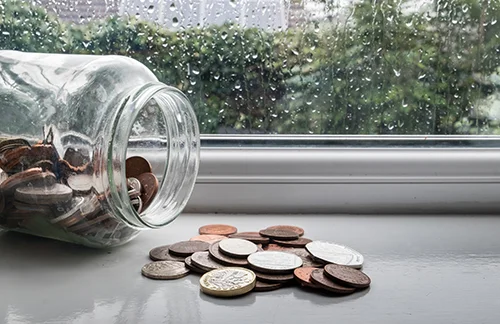When a sudden fuel price hike hit Johannesburg in early 2025, Thandi, a single mom, faced a R500 monthly increase in commuting costs, threatening her family’s grocery budget. With no savings, she turned to a mashonisa, only to owe double in months. South Africa’s economy is a rollercoaster—32.1% unemployment (Stats SA, Q4 2024), 8.5% inflation (February 2025), and a volatile rand make financial shocks all too common. Building a financial buffer, or emergency fund, is your shield against these storms, offering stability in a country with limited social safety nets. This blog answers how ordinary South Africans can save despite tight budgets, which tools and institutions to use, and why it’s critical now. You’ll explore the economy’s unpredictability, barriers to saving, practical steps to start small, and smart places to store your funds. Whether you’re a freelancer in Cape Town or a teacher in Limpopo, these strategies will empower you to build resilience and secure your future.
Why Is South Africa’s Economy So Unpredictable?
South Africa’s economy is a tough landscape for savers. Unemployment hovers at 32.1%, with youth unemployment at 60.2%, per Stats SA Q4 2024, limiting income for millions. The rand’s volatility—dropping from R14 to R18 against the USD in five years (SARB, 2020–2025)—drives up import costs, like fuel and food. Loadshedding, costing businesses R1 billion daily (Eskom, 2024), disrupts jobs and raises prices. Inflation, at 8.5%, outpaces wage growth (3–5%), while the SARB’s repo rate (8.25% in 2025) hikes loan repayments, squeezing budgets. Consumer confidence is low, with only 22% of South Africans optimistic about finances, per a 2024 Sanlam survey. Compared to stable economies like Germany (2% inflation, 3% unemployment) or Australia (4% inflation, 5% unemployment), SA’s volatility is stark. To navigate this, track expenses with a free app like 22seven, set a weekly financial check-in, and read SARB’s economic updates at www.resbank.co.za. Understanding these challenges highlights why a financial buffer is non-negotiable.
What Is a Financial Buffer and Why Does It Matter?
A financial buffer, or emergency fund, is money set aside to cover unexpected expenses—car repairs, medical bills, or job loss—without borrowing. Experts recommend 3–6 months of living expenses (e.g., R15,000–R30,000 for a R5,000 monthly budget), though even R2,000 can make a difference in SA’s unpredictable economy. Take Lerato, a Durban freelancer who lost three clients during COVID-19 but covered rent and groceries for two months with her R10,000 savings, avoiding high-interest loans. A buffer offers peace of mind, reducing stress—65% of South Africans report financial anxiety, per a 2023 Sanlam survey—and prevents reliance on mashonisas or credit cards charging 20–60% interest. With SA’s limited social security (e.g., UIF covers only 38–60% of income for 6 months), a buffer is your safety net. To start, list monthly expenses, set a R500 savings goal, and commit to weekly progress checks. This small step builds resilience against economic shocks.
Barriers to Saving in South Africa
Saving in South Africa feels like climbing a mountain. Low incomes plague the working poor—50% of households earn under R6,000/month, per Stats SA 2023, leaving little after essentials. The high cost of living varies: Johannesburg households spend R15,000/month on rent, food, and transport, while rural Limpopo averages R8,000, per a 2024 PMBEJD report. Black Tax, supporting extended family, affects 70% of black South Africans, diverting R500–R2,000 monthly, per Old Mutual’s 2024 Savings Index. Distrust in banks, fueled by past scandals like VBS Mutual Bank’s collapse, makes people wary, with 20% preferring cash savings, per FinMark Trust 2023. Low financial literacy—only 30% understand basic finance, per Sanlam 2024—hinders planning. SA’s household savings rate is a dismal 0.5%, compared to India’s 20% (World Bank, 2023). To overcome these, join a community savings group, attend free financial workshops via Black Sash, and start with R20 weekly to build confidence.
Practical Steps to Start Saving Small
Building a financial buffer doesn’t require a big salary—just small, consistent steps. Track income and expenses using Excel or a notebook to spot leaks like R200 monthly on Uber Eats or R50 daily data top-ups. Cut invisible spending: Sipho, a Cape Town teacher, saved R200/month by switching to minibus taxis and downgrading his cellphone plan from R500 to R200. Set micro-goals: Save R50/week (R200/month), then scale to R100. Use cash envelopes for groceries or transport to curb overspending. Join a stokvel, a cultural gem—80% of SA stokvels save R500–R2,000 monthly, per NASASA 2024, with members sharing lump sums yearly. Automate savings via bank apps like Capitec’s Save feature, transferring R50 weekly to a separate account. Celebrate small wins: Reward reaching R1,000 with a coffee, not a splurge. To begin, list three expenses to cut, set a R200 monthly goal, and join a local stokvel via community networks. These steps make saving achievable, even on a tight budget. Here is a comparison of monthly household expenses in South Africa (2024):
| Expense Category | Johannesburg (Urban) | Limpopo (Rural) | Impact on Savings |
| Rent/Housing | R7,000 | R3,000 | High rent in urban areas leaves less for savings; rural housing is cheaper but often informal. |
| Food/Groceries | R4,500 | R2,800 | Urban food costs, driven by convenience purchases, cut savings; rural reliance on local markets saves slightly. |
| Transport | R2,000 | R1,200 | Urban commuting (taxis, fuel) drains budgets; rural transport is lower but limits job access. |
| Utilities | R1,200 | R800 | Loadshedding drives urban generator costs; rural areas face lower but unreliable electricity costs. |
| Black Tax/Support | R1,500 | R1,000 | Family obligations reduce savings, especially in urban areas with higher expectations. |
| Total | R16,200 | R8,800 | Urban households have ~30% less disposable income for savings than rural ones. |
Source: Pietermaritzburg Economic Justice & Dignity Group (PMBEJD), 2024 Household Affordability Index; Old Mutual Savings & Investment Monitor, 2024.
Tools and Institutions to Boost Your Savings
South Africa offers diverse savings tools, each with pros and cons. Bank savings accounts vary: Capitec Global One offers 4–7% interest, no monthly fees, and instant access; Nedbank MyPocket gives 3–5% interest but charges R5–R10 for withdrawals; TymeBank GoalSave yields up to 8% interest with 10-day notice, ideal for discipline. Fixed deposits (e.g., FNB 32-Day Notice) lock funds for 7–60 days, earning 6–9%, but penalize early withdrawals. Mobile platforms like Franc (invest from R5, 7% returns) and EasyEquities (low-cost shares) suit tech-savvy savers, while 22seven tracks budgets. Stokvels, digitized via StokFella, manage group savings securely, with R100 billion saved annually, per NASASA 2024. RSA Retail Savings Bonds (7–10% interest, R1,000 minimum) are government-backed but lock funds for 2–5 years. To choose, compare fees and access on bank websites, start with a TymeBank GoalSave, and explore Franc for small investments. Here’s a comparison:
| Account | Interest Rate | Fees | Access | Best For |
| Capitec Global One | 4–7% | None | Instant | Beginners |
| Nedbank MyPocket | 3–5% | R5–R10/withdrawal | Instant | Flexible savers |
| TymeBank GoalSave | 5–8% | None | 10-day notice | Disciplined savers |
| RSA Retail Bonds | 7–10% | None | 2–5 years | Long-term savers |
Building a Saving Habit on a Tight Budget
Saving is as much about mindset as money. South Africans often chase instant gratification—new sneakers or data bundles—over long-term security. To shift this, adopt the “Pay Yourself First” approach: transfer R50 to savings before paying bills. Round-up savings via apps like Capitec’s SnapSave (e.g., R99.50 purchase rounds to R100, saving 50c) add up to R500 yearly. Save windfalls like tax refunds or bonuses—deposit 50% into savings. Automate transfers to a TymeBank GoalSave account to avoid temptation. Create accountability: Join a savings challenge (e.g., 52-week challenge, saving R10–R520 weekly) or partner with a friend. Nomsa and Thabo, a Soweto couple, saved R20,000 in a year by automating R400 monthly and cutting takeaways. To build the habit, set a R100 weekly auto-transfer, join a savings group on WhatsApp, and track progress monthly. Consistency turns small savings into a robust buffer.
Where to Store Your Emergency Fund
An emergency fund needs liquidity (quick access) and safety, not high returns. High-interest savings accounts like TymeBank GoalSave (5–8%) or Capitec Global One (4–7%) are ideal, offering instant or 10-day access with no fees. Money market funds, like Allan Gray’s (6–7% returns), provide stability but require R1,000 minimums and 2–7 days’ notice. Avoid volatile stocks or cryptocurrencies, which can crash—Bitcoin dropped 20% in Q1 2025, per Luno. Inflation risk (8.5%) erodes savings’ value, so choose accounts with 5%+ interest to stay ahead. For example, R5,000 in a 7% GoalSave account grows to R5,350 in a year, beating inflation. Split funds: Keep R2,000 in instant-access accounts for urgent needs and R3,000 in notice accounts for growth. To optimize, open a TymeBank GoalSave, check interest rates quarterly, and avoid locking funds in long-term bonds. This balances safety and value.
Diversifying Income to Boost Your Buffer
A side hustle can supercharge your savings. With 60% of South Africans freelancing or hustling, per a 2024 Old Mutual survey, options abound: drive for Bolt (R5,000–R10,000/month), teach English online via TeachMe2 (R200/hour), or sell crafts on Etsy. Nkululeko, a Pretoria IT technician, earns R3,000/month tutoring coding on Upwork, saving 70% for his buffer. Use extra income to hit savings goals faster—deposit R500 monthly to reach R6,000 in a year. Upskill via free platforms like Google Digital Garage to access global gigs. Network locally at community markets or online via X to find clients. To start, list your skills, sign up for Fiverr or Bolt, and save 50% of hustle income. Diversifying income builds your buffer and financial independence.
Handling Setbacks: Using and Replenishing Your Buffer
Dipping into your buffer isn’t failure—it’s strategy. Set rules: use it for true emergencies (e.g., medical bills, job loss), not wants (new phone). If you withdraw R2,000 for car repairs, replenish it by cutting R200 monthly from takeaways for 10 months. Pause non-essential spending (e.g., Netflix) until restored. Rebuild by saving R50 extra weekly or redirecting side hustle income. For example, Zinhle, a Rustenburg hairdresser, used R3,000 for medical costs but rebuilt it in six months by saving R500 monthly from braiding gigs. Track withdrawals in a notebook to stay disciplined. To prepare, define emergency criteria, set a replenishment plan, and review your budget post-withdrawal. This mindset keeps your buffer strong and your goals on track.
Empowerment Through Preparation
Saving in South Africa’s volatile economy is tough but essential. Unemployment, inflation, and loadshedding make financial shocks inevitable, but a buffer—starting with R50 weekly—offers resilience. Track expenses, cut leaks, automate savings, join stokvels, and explore side hustles to build your fund. Tools like TymeBank GoalSave, Franc, and 22seven make it easier, even on a tight budget. As financial coach Maya Fisher-French says, “Savings don’t just secure your wallet—they secure your freedom.” Start today: open a savings account, save R20 this week, join a stokvel, and commit to a monthly budget check. Small, consistent actions outshine big intentions. With a financial buffer, you’ll face SA’s economic storms with confidence and control.


